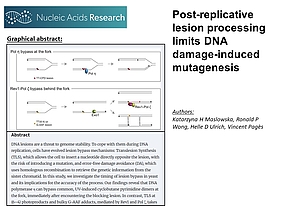New publication by the Ulrich lab on how post-replicative lesion processing limits DNA damage-induced mutagenesis
Masłowska KH, Wong RP, Ulrich HD, Pagès V (2025) Post-replicative lesion processing limits DNA damage-induced mutagenesis.Nucleic Acids Res., doi: 10.1093/nar/gkaf198 Link
Abstract:
DNA lesions are a threat to genome stability. To cope with them during DNA replication, cells have evolved lesion bypass mechanisms: Translesion Synthesis (TLS), which allows the cell to insert a nucleotide directly opposite the lesion, with the risk of introducing a mutation, and error-free damage avoidance (DA), which uses homologous recombination to retrieve the genetic information from the sister chromatid. In this study, we investigate the timing of lesion bypass in yeast and its implications for the accuracy of the process. Our findings reveal that DNA polymerase η can bypass common, UV-induced cyclobutane pyrimidine dimers at the fork, immediately after encountering the blocking lesion. In contrast, TLS at (6–4) photoproducts and bulky G-AAF adducts, mediated by Rev1 and Pol ζ, takes place behind the fork, at post-replicative gaps that are generated downstream of the lesion after repriming. We show that in this latter situation, TLS competes with the DA pathway, thus reducing overall mutagenicity of damage bypass. Additionally, our study demonstrates that Exo1 nuclease influences the balance between TLS and DA by modulating the size of the post-replicative gaps.
Read the full paper here: https://academic.oup.com/nar/article/53/6/gkaf198/8089748?login=true

